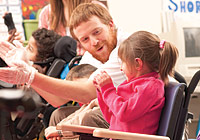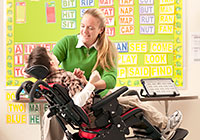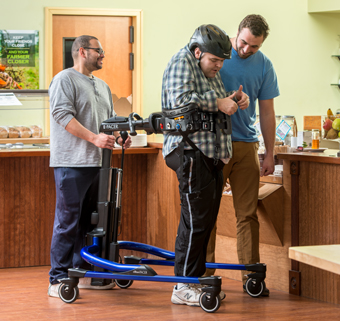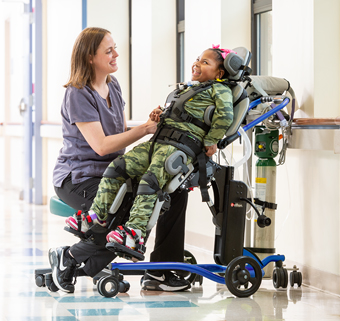Pediatric Adaptive Seating Benefits: Doing Away with Passive Seating
Welcome to part II of the post series on Active Sitting for Task Participation: The Role of Adaptive Chairs.
| April 2011Adaptive seating is a big part of pediatric and school-based therapy. Active sitting chairs, through providing unique features and prompts, support postures that enable. With this in mind, the following post series will be dedicated to exploring the concepts and benefits of adaptive seating. The first post – Active Sitting for Task Participation: The Role of Adaptive Chairs – is introductory and will get you off to a good start. Now, learn more with these two posts – Pediatric Adaptive Seating Benefits: Doing Away with Passive Seating and Symmetrical Posturing and Adaptive Seating for Task Participation. Full acknowledgment for concepts regarding adaptive seating for task performance is credited to Karen M. Kangas OTR/L. Material has been presented at the 18th International Seating Symposium and published in Rehab Management.
 Pediatric Adaptive Seating Benefits: Doing Away With Passive Sitting and Symmetrical Positioning
Pediatric Adaptive Seating Benefits: Doing Away With Passive Sitting and Symmetrical Positioning
Individuals who are not mobile have little active experience with gravity. Children with neuromotor impairments such as hypertonicity are often in seating systems in which they are “stabilized” by “not moving.” Restricted, static, symmetrical seated postures do not allow for active pelvic stabilization. As a result, these children have further difficulty learning how to integrate sensory–motor information for functional seated motor skills, especially head/eye/hand coordination.
Let’s look at a typical wheelchair posture. Reclined with knees higher than hips, a decreased hip angle, and feet off the floor on raised footplates, the pelvis is in a static posterior tilt. Lower extremities are symmetrically abducted, often with knees placed wider apart than the hips. Feet may be parallel to the floor with knees at more than 90 degrees flexion. Although this position may reduce hypertonicity, it prevents any weight bearing on the thighs and feet, and certainly does not allow the pelvis to tilt anteriorly as would be the case in an active sitting chair.
This is a resting, leisure, receptive posture in which tone is temporarily reduced. It is a passive, safe, symmetrical posture appropriate for transportation that does not allow any independent control.
Similarly, let’s look at the 90/90/90 seated position in comparison to pediatric adaptive seating. The concept for this posture is that by placing hips, knees, ankles and body in midline, this symmetrical posture provides control of tone and thus is optimal for sitting. But since this positioning is an attempt to maintain static symmetry for a child with increased or variable tone, a multitude of positioning straps are used to hold the child in place. Using straps does not allow the body to learn how to actively move in relation to gravity. Instead, this restriction prevents movement. For a child with high tone, it may even result in the body “fighting” the restrictive straps, in effect adding more power at those restraining points. Meanwhile, a child with low tone simply collapses their body into the many accessory supports and straps. The larger and more secure the straps, the more their body relies on the accessory supports.
Placed in wheelchairs in passive, static symmetrical postures, these children have great difficulty (without the experience of pelvic weight bearing) to find the active seated posture for function and task participation. With activity–focused adaptive seating, we no longer manage tone by attempting to stop or prevent it. Rather, we use positioning to enable individuals to control their tone with task–purpose. As we better understand how a body without adequate weight bearing works, we can provide systems that will allow better weight–bearing for pelvic stability and mobility to occur.
 We want functional sitting, so we must enable active movement and tone to perform work. With that, task participation is made possible and on-going motor practice attained. By providing seating that is designed to assist individuals to assume active sitting, they too, can learn this functional posture. Once obtaining it, individuals can practice active sitting in the context of learning tasks. Over time this posture will be more easily assumed, practiced, and obtained until the needed supports can be reduced.
We want functional sitting, so we must enable active movement and tone to perform work. With that, task participation is made possible and on-going motor practice attained. By providing seating that is designed to assist individuals to assume active sitting, they too, can learn this functional posture. Once obtaining it, individuals can practice active sitting in the context of learning tasks. Over time this posture will be more easily assumed, practiced, and obtained until the needed supports can be reduced.
Read the next post in this series: Symmetrical Posturing and Adaptive Seating for Task Participation. It includes a discussion on the features that are important to adaptive seating equipment.






